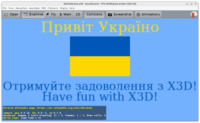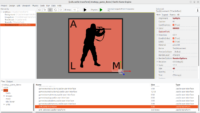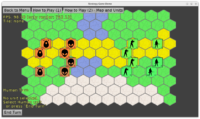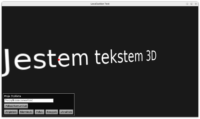 |
 |
 |
 |
Our usually-weekly news announcements have been quieter in November, I know. I blame it on me being somewhat exhausted from a ton of work and talking about the engine recently. But let’s get back on track, let me do some noise in the upcoming days about all things we did / are doing 🙂
Let’s start with font and text updates.
-
Our default fonts, embedded in the engine, have been extended to include over 2000+ common Unicode characters to cover most languages in the world. This means that, for most people, rendering the special characters in your native languages should just work out-of-the-box
This applies to all kinds of rendering. In particular using TCastleLabel (2D, UI) and TCastleText (3D, in viewport). As long as you leave their
CustomFontequalnil(default) to keep using the default font.Rendering X3D / VRML (using any engine tool, like view3dscene) also now automatically shows local characters. Test e.g. various international “Hello World” X3D examples from this page (open
.x3dor.x3dvfiles linked from there in views3dcene).Note that it doesn’t change what characters are present in your custom defined fonts. You still can (and should) customize the
TCastleFont.LoadCharactersto include all glyphs from all languages you plan to support.Almost all common glyphs are included, except the languages that have really typically a lot of characters: Chinese, Japanese and Arabic. If you find your language characters missing, let us know, and I will likely “just add a few more characters” to the default font. Unless your language has really a lot of specific glyphs.
-
The embedded 3D fonts have also a bit higher quality (generated with 25 size instead of 20).
-
To counter the explosion of font data in the engine (which could slow compilation time), we followed this with some cleanups:
-
We removed some old unused UI fonts from the engine (with sizes 10, 15, 18).
-
We removed 11 font variants embedded previously to support 12 possible combinations of X3D
FontStyle(3 typefaces, bold or not, italic or not). Now we just embed Sans-Serif font, not bold, not italic, by default.To render other fonts, we advise to define custom fonts, as documented in Text and fonts manual. Define as many fonts as you want, use
TCastleFontFamilyto define a collection (bold or not, italic or not) of fonts to be used e.g. withTCastleLabel.Htmlrendering. See the fonts/html_text example.If you want to specifically render X3D with full support for 12 variants possible by
FontStyle, then do what view3dscene source code now does: embed the additional fonts and adjust DefaultFontData map to use them. - We renamed font files to be independent of the font size, so that we can easily change sizes in the future. All in all, src/fonts is now much simpler.
-
-
We have also fixed rendering of fonts on ancient hardware, without OpenGL 3.
This typically happens on Windows virtual machines, that have ancient OpenGL 1.1 by default. And we deliberately do support it. We’re committed to supporting any OS configuration, as long as that OS has security support; so e.g. modern Windows is supported, no matter on how poor hardware you will use it; but Windows XP is not :). Note: if you want to get newer OpenGL on Windows virtual machines, Mesa builds for Windows are quite useful. Unless of course you can enable “real” 3D acceleration by making host GPU used efficiently by OpenGL inside the client.
Notes about things planned, but not done here:
-
We want in the future to enable loading “on demand” additional font glyphs (for entire language sections) from font files. This would mitigate the current need to just embed a lot of font glyphs by default.
-
We want to finish distance field fonts rendering method, to improve the font quality without the need for alternative font sizes.